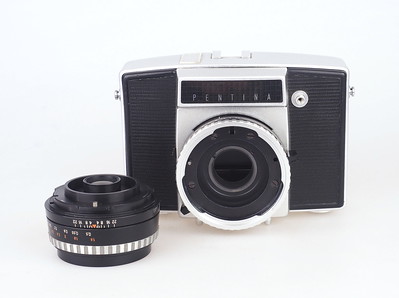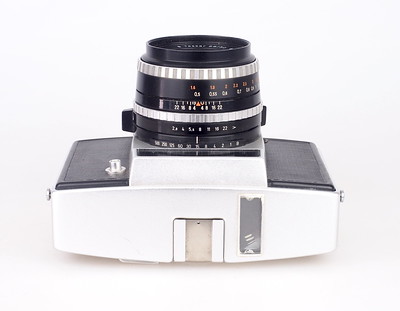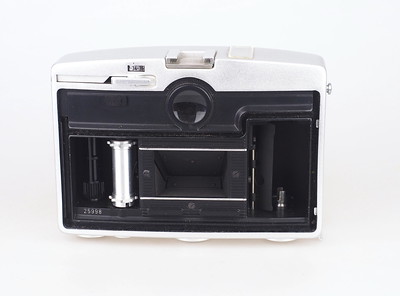Pentina

|
| image by Christoph Batz (Image rights) |
The Pentina is a quite unusual leaf-shutter SLR made by the East-German VEB Kamera- und Kinowerke Dresden between 1961 and 1965 [1]. In 1964 the company was renamed VEB Pentacon, where also the name Pentina was derived from. VEB Pentacon and its predecessor companies were rather known for their successful series of focal-plane shutter SLRs (Contax, Praktica, Exa, etc.) and designing and producing a rather complex but technically limited leaf-shutter SLR seemed like a setback. However, during the late 1950ies the West-German competition (namely Kodak Retina, Voigtländer and Zeiss Ikon) successfully implemented coupled Selenium meters into their leaf-shutter SLRs. This obviously was the driving force for the East-Germans to also develop a model for this market segment.
Specifications
- SLR camera 24x36 mm with built-in prism viewfinder
- Interchangeable lenses with Pentina plug-in bayonet
- Selenium light meter with needle meter reading on top of the camera
- Film speed setting 6-1600 ASA in both, ASA and DIN scale
- Match-needle metering with adjacent aperture and shutter time rings around the lens, advertised as (semi) automatic exposure.
- Quick-release lever (like the shutter button on the left camera side), mirror does not return automatically
- Prestor-00 reflex leaf-shutter with exposure times from 1 s to 1/500 s and B
- Flash synchronization M or X, switchable, extremely short electronic flash times possible
- Image counter
- Self-timer
- Rewind crank (bottom of camera)
- Accessory shoe (cold)
- Film type marker (bottom of camera)
- Tripod socket ¼ "
Lenses

|
| Pentina bayonet mount image by Christoph Batz (Image rights) |
The Pentina features exchangeable lenses through a special breechlock type bayonet mount. Four lenses were available:
- Carl Zeiss Jena Tessar 1:2,8/50 mm (standard lens with every camera)
- Meyer Lydith 1:3,5/30 mm
- Carl Zeiss Jena Cardinar 1:2,8/85 mm
- Meyer Domigor 1:4/135 mm
In early brochures a Meyer Domigon 1:3,5/30 mm was mentioned, which never made it into production. The lenses have built-in apertures, but no aperture ring to set them. This was part of the so called Kombisteller arrangement of shutter-time and aperture rings on the camera itself.
Models and Variations
There were four variants of the camera, which can clearly be distinguished by the model plate:
- Pentina (base model, see specs above)
- Pentina M (base model with additional split image focus aid)
- Pentina fm (base model with split image and micro-prism focus aid)
- Pentina E (simple model without the exposure meter)
Richard Hummel states in his book [2] that there was a first (Type I, 1961-1963) and a second generation (Type II, 1961-65) of the camera. This has proved wrong, as with some other statements in this book.[1] There have been a few deviating studies (assigned as type I), which never went into production [3]. Only the type II camera (according to Hummel), was the one that was mass-produced from the start and was shown in the early 1960s brochures.
Image galery
|
|
| ||||||
| Pentina top, bottom and (open) back images by Christoph Batz (Image rights) | ||||||||
Notes and References
- ↑ 1.0 1.1 Comprehensive Pentina article on www.dresdner-kameras.de (in German)
- ↑ Hummel, Richard. Spiegelreflexkameras aus Dresden - Geschichte, Technik, Fakten. Stuttgart: Lindemanns, 1998. ISBN 3895061271
- ↑ Heinz Schrauf, Pentina - Sein oder nicht-Design? in PhotoDeal IV / 2000


